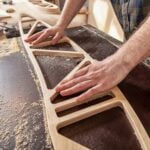Are you wondering how to make a woodworking shop? Setting up your own woodworking shop can be an exciting and rewarding endeavor for those who are passionate about working with wood. Whether you’re a hobbyist or a professional woodworker, having a dedicated space to work on your projects is essential for efficiency, safety, and organization.
In this article, we’ll guide you through the process of creating your own woodworking shop from start to finish. From finding the perfect location, selecting the right tools and equipment, designing an efficient layout, implementing safety measures, choosing the best materials, maximizing space and storage, and doing it all on a budget – we’ve got you covered.
Having a woodworking shop allows you to unleash your creativity while also providing a functional space for building and completing projects. With the right guidance and resources, you’ll be well on your way to establishing a productive and enjoyable woodworking environment that suits your needs and preferences. So let’s dive in and start building the woodworking shop of your dreams.
Finding the Right Location for Your Woodworking Shop
When it comes to setting up a woodworking shop, finding the right location is crucial for the success and efficiency of your projects. One key consideration is the space and size of the area. A woodworking shop typically requires a lot of space for tools, equipment, and the actual work area. Look for a location that can accommodate all these needs, while still leaving enough room for movement and flexibility.
Another important factor to consider is ventilation. Since woodworking involves cutting, sanding, and finishing materials, it’s essential to have good airflow to minimize exposure to dust and fumes. A well-ventilated location will not only create a healthier work environment but also prevent build-up of airborne particles that could potentially affect the quality of your projects.
Lastly, accessibility should be taken into account when choosing the location for your woodworking shop. Consider how easy it is to transport materials and finished products in and out of the space. Additionally, having access to utilities such as electricity and water is essential for powering up tools and cleaning up after projects.
| Consideration | Importance |
|---|---|
| Space and Size | Accommodate tools and movement |
| Ventilation | Healthier work environment |
| Accessibility | Transport materials and access utilities easily |
Keep these factors in mind when searching for the perfect location for your woodworking shop in order to create an optimal working environment that will benefit both you and your projects in the long run. Whether it’s a spare room in your home or a dedicated workshop space, finding the right location sets the foundation for a successful woodworking venture.
Essential Tools and Equipment for Setting Up a Woodworking Shop
Basic Hand Tools
One of the most important aspects of setting up a woodworking shop is having the right tools. Basic hand tools such as chisels, hand saws, block planes, and screwdrivers are essential for any woodworking project. These tools allow you to work with precision and detail, making them indispensable for your woodworking shop.
Power Tools
In addition to hand tools, power tools are necessary for more complex projects. A table saw, power drill, router, and orbital sander are just a few examples of power tools that can make your woodworking projects much easier and more efficient. It’s important to invest in high-quality power tools that will last a long time and provide reliable performance.
Measuring and Marking Tools
Accurate measurements are crucial in woodworking, so it’s essential to have measuring and marking tools in your shop. Tape measures, combination squares, sliding bevels, and marking gauges are all important for ensuring that your cuts and joints are precise. Without these tools, it would be nearly impossible to achieve the level of accuracy needed for fine woodworking.
Investing in high-quality tools is crucial when setting up a woodworking shop. These essential tools will form the foundation of your workshop and enable you to take on a wide range of projects with confidence and precision. Knowing how to make a woodworking shop functional involves not just having the right space but also the proper equipment to bring your projects to life.
Designing and Organizing Your Woodworking Shop Layout
When setting up a woodworking shop, one of the most crucial aspects is planning and organizing the layout of the space. A well-designed layout can help maximize efficiency, productivity, and safety in your woodworking shop. Start by determining the overall workflow of your projects – from wood storage to cutting, assembling, finishing, and packaging. Consider the traffic flow and allocate specific areas for each stage of the woodworking process.
Next, think about the placement of your workbenches and machinery. It’s important to have enough space around your tools for maneuvering and to prevent any accidents. Also, consider installing proper ventilation systems to maintain good air quality in your workspace. Additionally, ensure that there is plenty of natural or artificial lighting to help you see clearly while working on intricate projects.
Furthermore, organizing small items like nails, screws, and other hardware is essential for efficiency. Utilize wall-mounted racks, bins, or drawers to keep these items within easy reach without cluttering your work surfaces. Labeling shelves and storage containers will also help you quickly find what you need during a project.
| Woodworking Shop Layout Tips | Benefits |
|---|---|
| Determine overall workflow | Maximize efficiency and productivity |
| Allocate specific areas for each stage of the woodworking process. | Organize workflow |
| Proper ventilation systems | Maintain good air quality in workspace. |
Safety Measures and Best Practices for a Woodworking Shop
Personal Protective Equipment (PPE)
When setting up your woodworking shop, it’s crucial to prioritize safety by investing in the appropriate personal protective equipment (PPE). This includes safety goggles, hearing protection, dust masks, and work gloves. These items are essential for protecting your eyes, ears, lungs, and hands from potential hazards in a woodworking environment.
Tool Maintenance and Inspection
Regular maintenance and inspection of tools and equipment is vital for ensuring a safe woodworking shop. All tools should be kept in good working condition, with sharp blades and properly adjusted settings. Inspect power cords regularly for any signs of damage and replace them if necessary. Additionally, it’s important to follow manufacturer guidelines for tool maintenance and use.
Dust Collection and Ventilation
Woodworking generates a significant amount of sawdust and airborne particles that can pose health risks if inhaled. To mitigate this, implementing a dust collection system and proper ventilation in your woodworking shop is essential. A dust collector with a high-efficiency particulate air (HEPA) filter can help capture fine particles, while ensuring good airflow will help expel airborne contaminants from the workspace.
By taking these safety measures into consideration when setting up a woodworking shop, you can create a safe and healthy environment for pursuing your passion for woodworking while minimizing the risk of accidents or injury. Remember that prioritizing safety is key to enjoying your craft for years to come.
Choosing the Right Materials for Your Woodworking Projects
When setting up a woodworking shop, one of the most important aspects to consider is choosing the right materials for your projects. The quality and type of wood you use can greatly impact the outcome of your creations, so it’s crucial to make informed decisions when selecting materials.
The first step in choosing the right materials is to consider the specific woodworking projects you plan to undertake. Different types of wood are suited for different purposes, so it’s essential to match the characteristics of the wood with the requirements of your project. For example, hardwoods like oak and maple are great for furniture making due to their strength and durability, while softwoods like pine and cedar are commonly used for decorative pieces.
Another important factor to consider when selecting materials for your woodworking projects is sustainability. As awareness of environmental issues continues to grow, many woodworkers are opting for sustainably sourced or reclaimed wood to minimize their environmental impact. This not only contributes to a more eco-friendly approach but also adds a unique and rustic charm to your creations.
Additionally, understanding the properties of different types of wood will help you make informed choices when selecting materials for your woodworking projects. Certain woods may be prone to warping or splitting, while others may have distinct grain patterns that add character to your finished pieces.
By familiarizing yourself with these characteristics, you can ensure that the materials you choose will contribute to the overall quality and aesthetic appeal of your creations. Incorporating this knowledge into how to make a woodworking shop will elevate not only its functionality but also its efficiency.
Tips for Maximizing Space and Storage in Your Woodworking Shop
When setting up a woodworking shop, one of the key considerations is maximizing space and storage. A well-organized and efficient workspace can increase productivity and make it easier to complete woodworking projects. There are several tips and strategies that can help you make the most of the available space in your woodworking shop.
One effective way to maximize space in a woodworking shop is to utilize vertical storage. Installing shelves, pegboards, and cabinets on the walls can free up valuable floor space and keep tools and materials within easy reach. Additionally, using wall-mounted tool racks and hangers can help keep frequently used tools organized and accessible while minimizing clutter on work surfaces.
Another tip for optimizing space in a woodworking shop is to invest in versatile furniture and workbenches with built-in storage. Workbenches with drawers, shelves, and cabinets provide ample space for storing tools, hardware, and other supplies while also serving as a functional workspace for various projects. Consider adding rolling carts or tool chests that can be easily moved around the shop as needed, providing additional storage without taking up permanent floor space.
Finally, implementing a systematic organization system can help maintain a tidy and efficient woodworking shop. Labeling storage bins, utilizing clear containers for small items, and establishing designated areas for different types of tools can make it easier to find what you need when working on a project. By keeping everything in its proper place, you can prevent clutter from accumulating and ensure that your woodworking shop remains functional and productive.
By following these tips for maximizing space and storage in your woodworking shop, you can create an organized and efficient workspace that enables you to pursue your passion for woodworking effectively.
Budget-Friendly Ways to Set Up a Woodworking Shop
Setting up a woodworking shop doesn’t have to break the bank. There are several budget-friendly ways to create a functional and efficient space for all your woodworking projects. Here are some tips on how to make a woodworking shop while keeping costs down:
- Repurpose and Upcycle: Look for used or old furniture, shelves, or storage units that can be repurposed for your woodworking shop. You can transform an old bookshelf into a tool storage area or use old cabinets for storing materials and supplies.
- DIY Workbenches and Tables: Instead of purchasing expensive workbenches and tables, consider building your own with affordable materials such as plywood and 2x4s. There are plenty of DIY plans available online that offer step-by-step instructions for building sturdy workbenches at a fraction of the cost.
- Shop Around for Second-Hand Tools: Don’t feel pressured to buy brand new tools right away. Shop around at yard sales, flea markets, and online marketplaces for second-hand tools in good condition. You can save a significant amount of money by purchasing pre-owned tools, especially when just starting out.
By implementing these budget-friendly approaches, you can create a fully functional woodworking shop without breaking the bank. With a little creativity and resourcefulness, you can set up a space that is not only affordable but also personalized to meet your specific needs. Remember that the goal is to have a safe and organized environment where you can unleash your creativity and hone your woodworking skills without worrying about the cost.
Conclusion
In conclusion, setting up a woodworking shop is an exciting and fulfilling endeavor for anyone passionate about working with wood. From finding the perfect location to choosing the right tools and materials, the process of creating a woodworking shop is a true labor of love. By following the tips provided in this article, you can ensure that your woodworking shop is not only functional but also safe and organized.
Remember, when it comes to setting up a woodworking shop, location is key. Whether it’s in your garage, basement, or a separate building, finding the right space will contribute greatly to your overall success. Additionally, investing in essential tools and equipment will allow you to tackle a wide range of projects with ease and efficiency.
Furthermore, don’t forget about safety measures and best practices while working in your woodworking shop. Prioritizing safety will not only protect you from potential injuries but also ensure that your projects are completed with precision and attention to detail. With the knowledge gained from this article, you are now better equipped to embark on your own woodworking shop journey and enjoy all the creativity and rewards that come with it.
Frequently Asked Questions
How to Set Up a Wood Shop at Home?
Setting up a wood shop at home involves careful planning and consideration of space, tools, and safety measures. Start by designating a well-ventilated area for your shop and invest in essential tools such as a table saw, band saw, drill press, and workbench.
Additionally, stock up on safety equipment like goggles, dust masks, and ear protection. It’s important to also think about dust collection and ventilation to maintain a healthy working environment.
Is Woodworking a Lucrative Business?
Woodworking can be a lucrative business for those with the necessary skills and business acumen. There is a demand for high-quality custom furniture, cabinets, and other wood products.
However, success in this field requires not only woodworking skill but also marketing savvy, financial management, and the ability to build a client base. Like any business venture, it requires dedication and hard work to turn a passion for woodworking into a profitable enterprise.
What Machines Do I Need in a Woodworking Shop?
A woodworking shop requires several key machines to efficiently produce quality products. These may include a table saw for precise cutting of wood pieces, a planer for smoothing rough-cut lumber, a jointer for creating flat edges on boards, and a router for shaping edges and cutting joinery.
Additionally, having machines like a band saw for curved cuts and resawing, drill press for accurate drilling, and dust collection system for maintaining cleanliness are essential in a well-equipped woodworking shop. Each machine serves specific functions that are crucial to the overall wood crafting process.

Hi everyone! I’m a woodworker and blogger, and this is my woodworking blog. In my blog, I share tips and tricks for woodworkers of all skill levels, as well as project ideas that you can try yourself.





